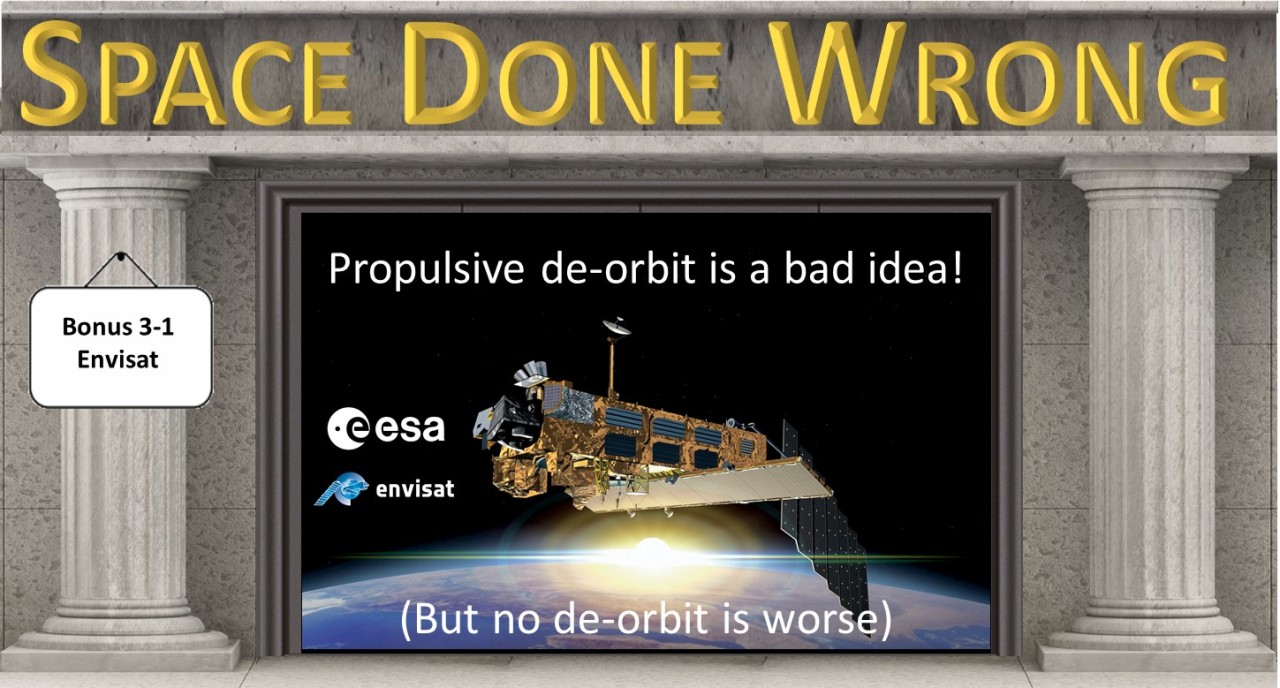How do you think you will do the de-orbit of your spacecraft? If you say you use the satellites propulsion system to do it, think again. If the mighty ESA does not have it in their heart to de-orbit a functional satellite why do you think you will? Let’s have a look!
About EnviSat
If you look at the ESA masters space debris list [6] there is one satellite at the top of the list: EnviSat. This 8140kg behemoth is the largest civilian satellite and the largest satellite the European Space Agency (ESA) ever built. Today EnviSat looks like a dead end, it was the last of the satellites which got bigger and bigger. The successor of ERS-2 was a multi-sensor monster that likely only ESA (or NASA) can come up with. If you want to get a overview on the mission I recommend EOportal [1] and the ESA Mission Page [2]. If you look at Envisat even the Copernicus Sentinel [9] satellites suddenly look measured.

EnviSat had a design life of 5 years and significantly outlived this goal as per the usual ESA over engineering. However, when the satellite suddenly died after 10 years in orbit it also documented one of the problems of space debris mitigation: moral dilemma.
The Nature of the Moral Dilemma
Imagine you have a working spacecraft which generates science data or is the base of your business. How big is the chance that you will de-orbit this spacecraft? You will ask me, why would I de-orbit a working satellite? Very easy, if your space debris mitigation plan is to de-orbit (or put to graveyard) your satellite using the main propellant system then you need a working satellite. If you need a working satellite for your propulsion system to work that means that you will have to de-orbit a functioning satellite – otherwise you won’t at all.
Nobody wants to de-orbit a working spacecraft but if you plan to use your propulsion module as primary de-orbit device you have to, or you will not at all.
However, as we have established above, nobody wants to de-orbit a functioning satellites. Just one more day, week, year. Just one more lifetime extension. Until well the mission ends unexpected and you have not de-orbited your spacecraft. That is what happened to ESA.
Just one more lifetime extension until one day you have lost your satellite and cannot de-orbit anymore.
This is the nature of the moral dilemma, you know that you should de-orbit your space craft. You also know that you can only do it while it is alive but the short term returns in scientific data (or money in case of commercial satellites) will put a big incentive to ignore long time hazards. And consequently this is the reason why it is a bad idea to assume you will use your main propulsion system to de-orbit the satellite. If ESA was not able to do it, would you?
Wait wasn’t there an ESA code of conduct?
The code of conduct [7] among other things states that your spacecraft has to be removed from critical orbits (<2000km & GEO belt) not later than 25 years after the end of nominal operations. This time has not yet passed – so ESA could still surprise us with an EnviSat removal mission – but considering the current state of affairs it will likely remain in orbit.

These rules which apply to all ESA missions were published in 2004 and thus admittedly after EnviSat was launched. That said, considering how long anything usually takes with ESA I am pretty sure that were discussions about how to deal with space debris at least 10 years prior. I therefore find it alarming that one side of ESA does the good deed of preparing a space debris mitigation initiative and the other just builds the largest civilian spacecraft and has no answer for this very pressing question.
ESA has championed space debris mitigation rules for long before they published their code of conduct. Why did they not act on it with EnviSat?
Ok, let’s say nobody in the EnviSat team ever heard from the space debris issue and while building this 8000kg monster of a satellite it also never came to their minds, then at the very least I would have expected that they at least follow their own rules once they are in place: the code of conduct in section 3.2 [7] says that every mission shall have a space debris manager who should present their findings in every review and have the authority to enforce the space debris mitigation plan so that the mission is in compliance with the rules.
I wonder who was the space debris manager of EnviSat or was the post vacant?
So while the satellite was evidently already launched that does not mean the end of reviews and consequently the space debris manager of Envisat should have cried murder for the future risk that EnviSat poses during subsequent reviews during the operational phase.
Maybe the code of conduct came too late for EnviSat but is it really true that nothing could have been done once launched?
Ok, then maybe nobody discussed the space debris issue and when it came up nothing could be done anymore if so, is that really the case or would EnviSat have been to comply with the code of conduct for space debris mitigation? This is actually a question that will be brought up by friends of ESA every time I point out EnviSat as the worst space debris offender which will stay in orbit for the more than 150(!) years [12]. I think this is an important question which we will look into next.
Did EnviSat have enough fuel for De-orbit?
According to Eoportal [1] Envisat had 319kg of Hydrazin fuel. Given a ISP of 220-230s this consequently means a propulsion ability of around 86-90m/s delta-v. The satellite was brought into an circular 800km SSO orbit and had a original mission of 5 years.
After the 5 year regular mission roughly half of the propellant were still there.
In 2007 after 5 years in orbit – at the end of the nominal mission life – the satellite still had 164kg of Hydrazine left [1] which corresponds to about 46m/s delta-v. This is not suitable to lower the orbit for direct re-entry but does not mean nothing could be done.
The propulsion of EnviSat was not sufficient to do direct de-orbit but other options were still on the table.
With this it would have been possible to perform half a Hohmann transfer to 625km. This means the resulting elliptical orbit would have been 625km perigee and 800km apogee.
Reducing the Perigee of the orbit to increase air drag would have been a viable option.
From this elliptic orbit the satellite would have used air drag mainly at perigee to first circularize and later naturally de-orbit the satellite. The chosen strategy is to use the ADCS of the satellite to put maximum surface of solar panel and large side into ram direction (124m²). Due to the fact that only OBC and a odd nadir pointing mode would have to run this would likely be power positive. Once the satellite fails (assumption 7 years after mission ends) the satellite starts to tumble and decays naturally with an average of ~64m² drag area.

Admittedly, doing this you will not achieve compliance with the code of conduct but the orbit life will be reduced by 2/3 to about ~60 years (from 150+) which I believe is much better than nothing.
Alternatively, if ESA would have been keen to really stick to their own code of conduct using the same controlled/uncontrolled strategy it would have been possible to forego the inclination change and orbit increase of EnviSat and except a propulsion reserve for collision avoidance (say 10m/s delta-v total) all propulsion goes into lowering the orbit of EnviSat after the 5 year mission. Then the remaining propulsion of 80m delta-v could have been used to put the perigee to 500km to expedite the de-orbit. In such a case the satellite would have de-orbited after 15 years and thus in full compliance with ESA’s code of conduct. Instead of being worst offender [12] they would have provided a good example on how to make the hard (but right) choice when it comes to space debris mitigation.

Unfortunately and as described in my initial statement ESA instead of de-orbiting the satellite when they could they went on to do the human thing. Which is to propose one mission extension after the other until the satellite suddenly was no more.
For EnviSat ESA had the chance to be compliant with the code of conduct or at the very least they could have reduced the time in orbit. Unfortunately they chose neither.
Now we are stuck with the largest civilian satellite ever built as a massive space debris in one of the most frequently used science orbits and it will stay there for a very long time.
Isn’t it ironic ESA’s Environmental satellite is a big threat to the space environment
I wonder whether at the point when the corpse of EnviSat collides with another object we will ask ourselves whether the increased service life of a satellite that was named after the environment was worth destroying the space utilization for everyone.
Concluding Remarks
There is one remaining question, though. Dear ESA, when will you remove EnviSat from orbit? You started out studies [11] but then abandoned the idea. Considering for what is at stake and for the shining light that you aim to be, I would encourage you to once again take up this idea. Yes, it will cost large amounts but again nothing against what will happen if on of your dead big birds collides with another space object. Thanks!
How can you help:
This text is part of a series of articles in which the author sets the framework to start a discussion about the wrongs of the space industry. If you have experienced similar things, leave a comment. Other views and opinions are very welcome, too, as they may present a way forward. Please be kind to each other.
Disclaimer
The author’s views are his own do not represent the views of Berlin Space Technologies.
[1] EnviSat Eoportal
[2] EnviSat ESA
[3] ESA code of conduct 2005 conference
[4] European Code
of Conduct v1.0 (2004)
[5] Galaxy 15 – Zombie Satellite
[6] ESA Masters
[7] ESA code of conduct for space debris mitigation
[8] Interagency Space Debris Mitigation Guidelines
[9] ESA Sentinel
[10] ESA privileges and Immunities
[11] ESA Cleanspace Initiative
[12] Envisat Space Debris & Deorbit
[13] Software to calculate de-orbit: CNES Stela
[14] Webtool to calculate Delta-V


Leave a Reply